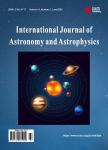Photometric and Statistical Analysis of Solar Energetic Particle (SEP) for the Peak of Solar Cycle 24
Photometric and Statistical Analysis of Solar Energetic Particle (SEP) for the Peak of Solar Cycle 24作者机构:Department of Physics College of Science University of Kirkuk Kirkuk Iraq Department of Physics and Astronomy University of Turku Turku Finland
出 版 物:《International Journal of Astronomy and Astrophysics》 (天文学与天体物理学国际期刊(英文))
年 卷 期:2016年第6卷第3期
页 面:276-287页
学科分类:07[理学] 070401[理学-天体物理] 0704[理学-天文学]
主 题:Coronal Mass Ejections CMEs Solar Wind Solar Energetic Particles SEPs SOHO-LASCO-ERNE: Data Base Solar Cycle (24)
摘 要:The major solar energetic particle events for the peak of solar cycle (24) for years (2012-2015) are analyzed by using the Energetic and Relativistic Nucleus and Electrons (ERNE) detectors and Large Angle and Spectrometric Coronagraph Experiment (LASCO) on board SOHO. It is found that the number of events which satisfies the required condition was 82 events. LASCO give information about Central Position Angle (CPA), Angular Width (AW), the speed of associated Coronal Mass Ejections (CMEs) and their basic features which cataloged in a data base SOHO/LASCO. The logarithmic intensity-time profile of SEP for the peak of solar cycle (24) was provided by ERNE, and from this profile the injection time, width, speed and onset time were estimated. All results that arise from these photometric analysis were statistically analyzed by using the statistical program SPSS (version 19). It have been concluded that 90% of these events were halo (360°) CPA, 1% of North West, 4% South West and 2% North East and South East, as well as it was found that 39% gradual events and 29% impulsive events while 32% were not clear events, and also the acceleration of the energetic particle is not only in the interplanetary but also in the location of the event. We found from the statistical analysis for these events that the acceleration is inversely proportional to speed and the relationship between them is not relevant and also the speed increase in two regions, from year 2012 and 2014. This confirms that the peak of solar cycle (24) really is double peak. All these investigations were employed as data base for the space agencies to protect the solar wind.



